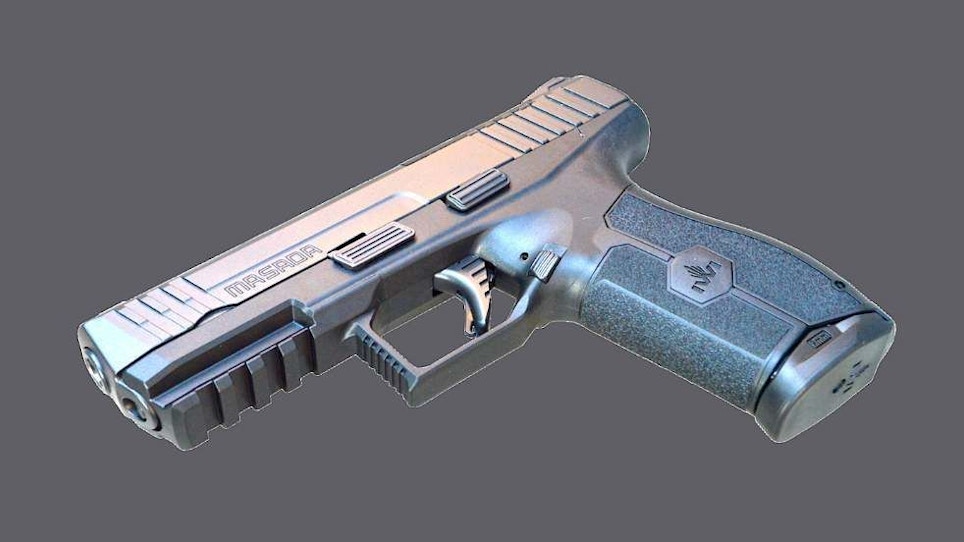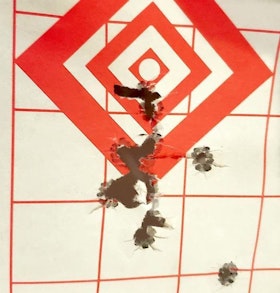IWI noted during the U.S. release that its new striker fired Masada is not a “me too” pistol, but a design that is an evolution of all the best pistol features in one affordable design. The Israeli military has a long history of harsh testing of a variety of handguns on the battlefield, recently including the IWI Jericho pistol models and other pistols including Glock variants.
The IWI Jericho is one of the most widely regarded and proven combat pistols in the military. However the all steel frame is also roughly a half pound heavier than most competing polymer framed pistols. It also is based on a more classic thumb safety design and operation many militaries and police are transitioning away from. Due to weight and manual-of-arms preferences, the Glock polymer-framed models have become extremely popular with Israeli military. With so much of the Israeli and other global militaries preferring a striker-fired pistol, IWI created the Masada as an option to Glocks … and it has done a stunningly spectacular job for a very cost-effective $439 MSRP.
Having reviewed all manner of industry polymer-framed guns, one might believe the Masada is the love child of the SIG 320, Walther PPQ and a Glock 17 featuring their best attributes. The SIG 320 users love the interchangeability of the serialized trigger unit to allow for frame, slide and caliber swaps and a simple disassembly that requires no trigger pull, all of which the Masada has.
Walther PPQ users like the grip customization, enlarged slide and mag releases, slide cuts, industry leading trigger feel and outstanding accuracy, which the Masada also delivers. Glock owners love the no-nonsense design, inexpensive magazines, simple operation, integrated safeties and very high grip-to-bore axis for fast shot strings and yes, the Masada also delivers those features.
Going Further With Design
In addition to a design that combines all these more brand-unique features into a single pistol, the IWI Masada went further with the overall design. The Masada features a 6-pound trigger break that notably is the best factory striker-fired trigger on the market and, for a striker-fired pistol, is very crisp. The factory trigger is shockingly amazing for a striker-fired gun with a trigger feel that is on par with aftermarket striker-fired triggers and spring kits from companies such as Apex. Customers do not need to worry about a trigger upgrade, but there is more they can cross off the upgrade list.
A common complaint on many striker-fired pistol models with gloved hands is the lack of room inside the trigger guard. But there the Masada has delivered more working room for gloved index fingers. The SIG and Glocks fall short with slide releases that can be difficult to find with gloves. The Masada’s slide releases are also oversized for gloved hand manipulation similar to the Walther PPQ releases.
Instead of an ambi-swappable magazine release configuration, the Masada is truly ambidextrous out of the box without the need for disassembly for a left-handed shooter. Left- and right-hand slide and magazine releases work with equal authority.
With the Masada, IWI paid a significant amount of attention to addressing the many complaints and typical upgrades customers have with striker-fired pistols. Upgrades include an enhanced trigger, sculpted and contoured magazine releases less prone to self-release in the holster, oversized slide release, forward slide manipulation cuts, deeper trigger guard forward serrations and reflex optic-ready slide without disassembly or modification, all for an MSRP price about $200 less than competing MOS-ready pistols. With an already excellent trigger, extended slide release and MOS-compatibility for the RMR right out of the box, the Masada buyer is getting a significantly upgraded gun right from the factory without the need for upgrades.
One of the more contentious points for a pistol shooter is the cost of magazines. Most SIG, H&K, Walther and S&W striker-fired pistol magazines have a $40 to $50 MSRP. IWI noted that with so many shooters buying upwards of a dozen magazines, they wanted to assure the price of the magazines was just as attractive as the price of the pistol and is retailing 17-round magazines for $29.99.
Feel, Fit and Design
The feel, fit and finish is every bit as nice as a buyer would expect on a SIG, H&K, S&W or Walther. Details are well defined and injection molding is precise, grip seams match up perfectly and the slide milling details are all very well executed. All the features customers would expect are there on the Masada, including an integrated light rail, plus a few contours on the slide, frame and muzzle just make the Masada a bit more comfortable to carry.
Many companies offer holsters for the Masada. The U.S. models at this time are only available with three-dot fixed non-illuminated sights — presumably because customers will likely add a reflex sight. Based on the success of the Masada, it is likely we will see other offerings added to the line including models with night sights, such as those available in Israel.
From an overall design perspective, IWI did a great job in defining its own unique design with the Masada. It feels good and if fitment is required, the grip is easily swapped with the included three grip size/shapes. Often grip options on pistols are very subtle. What I like about the three grips included with the Masada is they provide three significantly different grip shapes ranging from a larger and wider SIG-sized grip for large hands, to a Glock-ish feel, and a very slim FN grip feel.
Though the standard installed medium-sized grip has a good overall feel, one legacy Glock shooter who handled the Masada had to hunt for the RMR dot and the sights were presenting high for his natural grip. The easy fix was a swap to the smaller grip, which allowed the natural grip and indexing of the shooter to present a clear RMR sight dot perfectly. In many cases the customizable grips are seen as a bit gimmicky, however notably this was a demonstration that customizing the fit of the gun can have a substantial increase in comfort, speed and accuracy.
Function and Accuracy
The Masada functioned perfectly with the variety of FMJ and HP Winchester, Federal, Fiocchi, SIG and CCI Blazer aluminum and brass case ammunition shot during evaluation including several mixed magazines of ammunition. Accuracy shooting was done off-hand at seven and 25 yards between two different shooters who both delivered similar accuracy results and similar comments regarding the distinct preference of 124-grain rounds overall with a close second preference to 115-grain rounds.
Even the largest 147-grain groups were still great and the best 124-grain groups were stunning at the 7-yard line. To put these groups into perspective, the IWI Masada was shot side-by-side with a custom aftermarket match-barreled Glock 19 with a match trigger and light spring and connector kit and the Masada surpassed the Glock’s accuracy unless premium 147-grain match HP rounds were shot with the Glock.
Part of this accuracy can be attributed to the red dot sight, but most of the credit goes to the spectacular Masada trigger and the precision polygonal-rifled hammer-forged barrel tuned for standard NATO 124-grain rounds. Without question the Masada delivers shockingly impressive accuracy for a gun that is priced about $200 less than its competition.
Overall Impressions
The Masada will appeal to IWI fans and those customers who are always wanting to try something different. For the home defense buyer, the Masada offer a really impressive array of features that puts it on par with substantially more expensive pistols.
Smart dealers will likely offer reflex sight kits with the Masada, which would provide a significant apparent added value over competing guns in the cabinet. Even brand loyal customers of other competing striker-fired pistols will be impressed with the fit, finish and features of the Masada. Considering the $439 MSRP and deep features, the IWI Masada is coming to the U.S. market with a very strong competitive offering that is sure to convert some customers.







